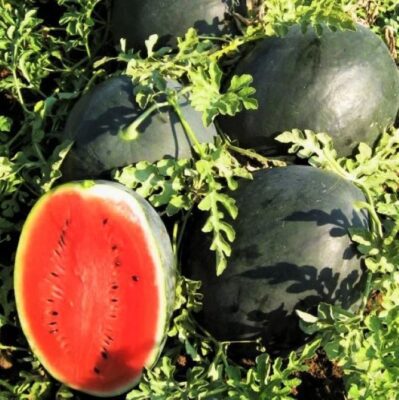This fruit is unique in its dark, almost black rind and sweet, red flesh. It’s also known for its large, round shape and small, edible black diamond watermelon seeds.
Black diamond watermelons are believed to have originated in Africa and were then transported to North America. The plants take about 3 months to mature and can grow up to 8 feet in length.
These watermelons are an excellent source of vitamins A and C and are low in calories. They are also packed with antioxidants, making them a great way to get your daily nutrient intake.
Where Do They Come From?

Black diamond watermelons are a rare and remarkable variety that has been around for centuries but only recently gained recognition. The plants that produce these unique fruits grow in tropical climates, requiring lots of sunlight and moist soil to thrive.
The plants have deeply lobed leaves and thick, green stems, and are easily identified by their characteristic black-and-white striped pattern.
How To Grow Black Diamond Watermelon In Containers?
Growing Black Diamond watermelons in containers can be a rewarding and enjoyable experience. While it may present some challenges due to their larger size, with the right techniques and care, you can successfully cultivate these delicious melons right on your patio or balcony. Here’s a step-by-step guide on how to grow Black Diamond watermelon in containers:
1. Select the Right Container: Choose a large container with a minimum size of 15 gallons to provide enough space for the watermelon’s roots to grow. Ensure the container has drainage holes to prevent waterlogging.
2. Soil Preparation: Use a well-draining potting mix enriched with organic matter. Watermelons prefer slightly acidic soil with a pH between 6 and 6.8. Mix in compost or aged manure to improve soil fertility.
3. Seed Selection and Planting: Purchase Black Diamond watermelon seeds from a reputable source. Start seeds indoors about 4 to 6 weeks before the last frost date in your area. Sow the seeds in biodegradable pots or seed trays, keeping them moist and warm until they germinate. Once the danger of frost has passed, transplant the seedlings into the container, making sure to bury them at the same depth as they were in their original pots.
4. Sunlight and Temperature: Watermelons require full sun to thrive. Place the container in a location that receives at least 6-8 hours of direct sunlight per day. The ideal temperature range for Black Diamond watermelons is between 70°F and 85°F (21°C to 29°C).
5. Watering: Adequate and consistent watering is crucial for watermelon plants. Water deeply when the top inch of soil becomes dry, ensuring that the water reaches the root zone. Be careful not to overwater, as this can lead to root rot. Mulching the soil surface with straw or wood chips can help retain moisture and regulate soil temperature.
6. Support and Trellising: Since Black Diamond watermelon plants can become heavy and sprawling, providing support or trellising can help keep the vines off the ground and minimize space requirements. Use a sturdy trellis or construct a support system with netting or twine to lift and secure the vines as they grow.
7. Pollination: Watermelons rely on pollinators, especially bees, for successful fruit set. To attract pollinators, plant companion flowers nearby, such as marigolds or zinnias. If you notice a lack of bees in your area, hand pollination can be done by using a small brush to transfer pollen between flowers.
8. Fertilization: Feed your Black Diamond watermelon plants with a balanced, slow-release organic fertilizer or use a water-soluble fertilizer formulated for fruiting plants. Follow the manufacturer’s instructions for application rates and frequency.
9. Pruning and Training: As the plants grow, you may need to prune excessive foliage and lateral vines to promote better airflow and focus energy on fruit production. Be cautious not to remove too much foliage, as watermelons rely on leaves for photosynthesis.
10. Pest and Disease Management: Monitor your plants regularly for common pests like aphids, cucumber beetles, or spider mites. Use organic pest control methods or insecticidal soaps if necessary. Preventing fungal diseases such as powdery mildew can be achieved by spacing plants properly and ensuring good air circulation.
11. Harvesting: Black Diamond watermelons are typically ready for harvest when the skin turns dark green or black, the bottom part changes from white to yellow, and the fruit makes a dull sound when tapped. Refer to the seed packet or variety-specific information for the estimated days to maturity.
Growing Black Diamond watermelons in containers requires patience, care, and attention to detail.
How To Pick a Ripe One
Finding the perfect black diamond watermelon can seem like a daunting task. However, you can easily find a ripe one with the proper knowledge and technique.
- The most reliable way to identify a ripe black diamond watermelon is to check its color.
- It should have deep green skin with white stripes running down it.
- The underside of the melon should also have a yellowish or cream-colored spot. This means it is ripe and ready to eat.
- Additionally, the melon should be heavy for its size and make a dull thudding sound when tapped.
Why Is My Black Diamond Watermelon Plant Only Producing Male Flowers?
If your black diamond watermelon plant only produces male flowers, it could be due to several factors.
- Firstly, it is essential to note that black diamond watermelon plants will only make male flowers if the temperature is between 60-85F. The plant won’t flower if the temperature is outside this range.
- Another possible reason your black diamond watermelon plant only produces male flowers is that the plants were not properly pollinated.
How Do You Know When a Black Diamond Watermelon Is Ripe?
The most significant indicator of a ripe watermelon is the shape of the melon itself. Black diamond watermelons have an oblong form, rounded corners, and a long, narrow point at the stem.
As the watermelon ripens, its color changes from light green to yellow to a golden brown. The other way to tell if your watermelon is ripe is to thump it. A ripe watermelon should sound hollow, like a drum.
You can also look at the underside of the melon where it was attached to the vine. If the melon’s bottom turns from green to white or yellow, it’s ripe.
Why Is It Called a Black Diamond Watermelon?
The black diamond watermelon, also known as a white melon, is a unique type of melon that is quite different from other varieties. The outside of the melon is a very dark purple and is covered in warts, which gives it its distinctive name.
It’s not uncommon to find these melons growing wild in certain parts of the world. The skin of the melon is thick, making it difficult to cut open.
The seeds inside a black diamond watermelon are small and black, hence the “black diamond” name. The plants used to grow this variety of melon are also quite distinct, as they produce primarily male flowers. The plants are typically smaller than other melons, and their fruit can range from small to large.
Conclusion
Black Diamond Watermelon is unique and special with its dark green skin and sweet flavor. This watermelon variety is highly sought after due to its sweet taste, large size, and easy cultivation.
Growing Black Diamond Watermelons can be a rewarding experience, especially if you have the space to let them climb and spread.
You can purchase black diamond watermelon seeds from many online retailers or buy black diamond watermelon plants from local nurseries or garden centers.

Holding a Ph.D. in Botany and boasting over 15 years of experience in horticulture and plant science, our author stands as a top authority on plant care and gardening. Their dedication to sustainable gardening practices and thriving greenery shines through on egreenplants.com, where they share their extensive knowledge and personal insights. Whether it’s mastering plant cultivation techniques or offering expert advice on plant care, their guidance ensures gardening enthusiasts receive reliable and actionable information. Follow their green journey on Instagram at @plantsandrocks for more tips and inspiration.

